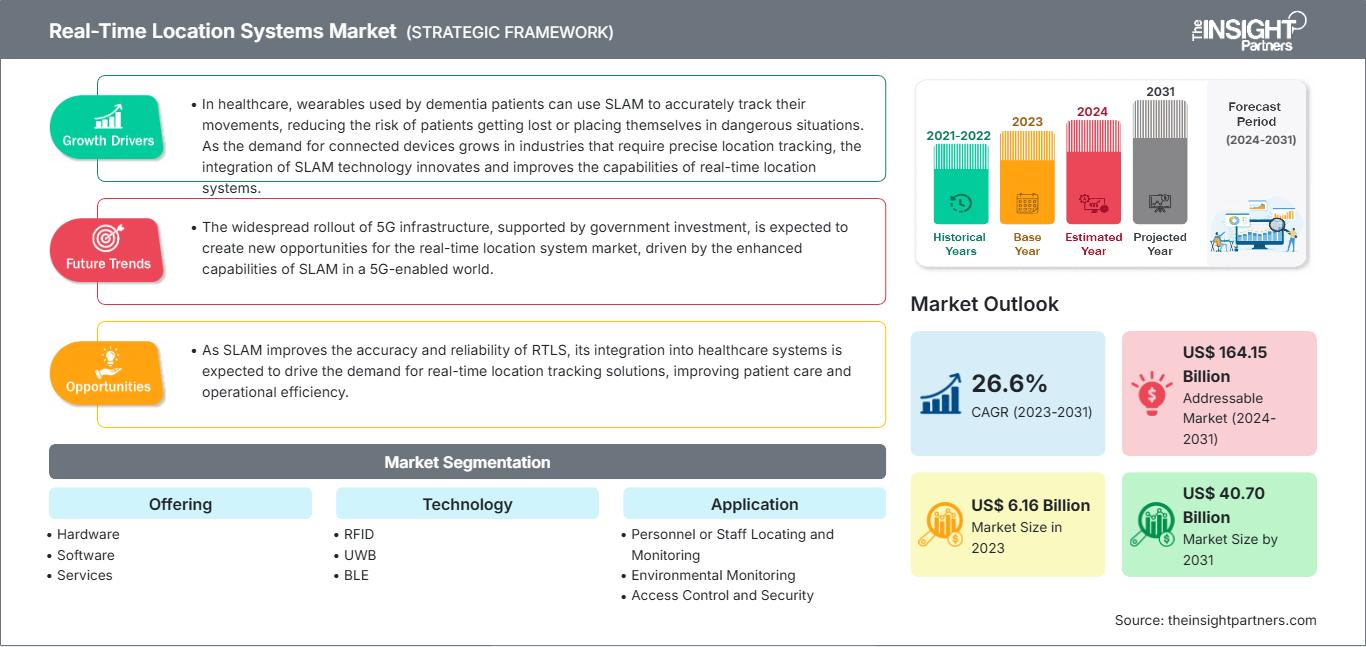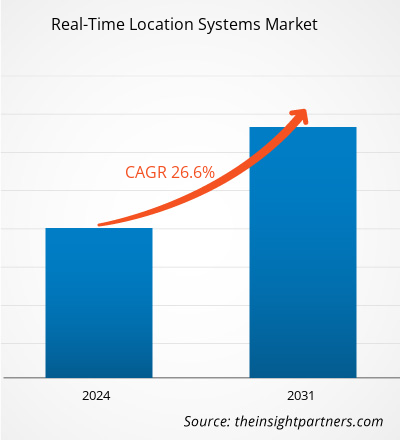实时定位系统市场规模预计将从 2023 年的 61.6 亿美元增至 2031 年的 407 亿美元。预计该市场在 2023 年至 2031 年期间的复合年增长率为 26.6%。实时定位系统在医疗保健领域的日益普及可能会成为市场趋势。
实时定位系统市场分析
全球对联网设备的需求正在不断增长,包括智能手机、平板电脑和各种可穿戴设备,如智能手表、健身追踪器、VR 耳机、联网眼镜、智能珠宝和蓝牙耳机。智能手机和平板电脑可帮助用户实时准确地跟踪位置信息。这些设备可帮助用户了解实时交通状况并找到到达目的地的最快路线。它还可以帮助父母通过不同的位置追踪应用程序监控孩子的活动。因此,智能手机和平板电脑的普及率正在大幅增长。据全球移动通信系统协会 (GSMA) 称,2022 年全球智能手机普及率为 76%,总计 64 亿智能手机连接。预计到 2030 年,这一数字将上升到 92%,全球连接数将达到 90 亿。根据同一份报告,2022 年北美的智能手机普及率为 84%,预计到 2030 年将飙升至 90%。同样,欧洲的智能手机普及率将从 2022 年的 84% 上升到 2030 年的 91%。在撒哈拉以南非洲地区,一个渗透率较低的市场,预计智能手机普及率将从 2022 年的 51% 增长到 2030 年的 87%。
实时定位系统市场概览
实时定位系统市场大致分为五大区域:北美、欧洲、亚太地区 (APAC)、中东和非洲(MEA)和南美(SAM)。北美在 2023 年占据最大市场份额,其次是欧洲和亚太地区。预计亚太地区在 2023 年至 2031 年期间的市场复合年增长率最高。
印度和中国等发展中经济体对实时定位系统的需求不断增长,预计将在预测期内为亚太地区的市场参与者创造丰厚的商机。不断增长的制造业、零售业和物流业增加了对资产跟踪的需求,从而刺激了该地区对实时定位系统的需求。上述行业对 RTLS 和 SLAM 的需求不断增长,鼓励市场参与者为客户提供先进的解决方案。据中国国务院称,中国零售业正在蓬勃发展,2023 年销售额将比上一年增长 11%,达到 2.24 万亿美元。这些国家对先进技术日益增长的需求预计将推动亚太地区实时定位系统市场的增长。
自定义此报告以满足您的要求
您将免费获得任何报告的定制,包括本报告的部分内容,或国家级分析、Excel 数据包,以及为初创企业和大学提供超值优惠和折扣
实时定位系统市场: 战略洞察

-
获取本报告的主要市场趋势。这个免费样本将包括数据分析,从市场趋势到估计和预测。
实时定位系统市场驱动因素和机遇
电子商务领域蓬勃发展
自新冠疫情爆发以来,全球网购激增。近年来,电子商务销售额显著增长。根据国际航空运输协会 (IATA) 的数据,2021 年,有 21.4 亿人(占世界人口的 27.6%)通过在线门户网站购物。此外,亚太地区引领全球电子商务市场,中国在该区域市场增长中占据显著份额。根据国际贸易管理局的数据,中国是全球最大的电子商务市场,占全球交易额的 50%。2021 年,中国通过电子商务领域创造了 1.5 万亿美元的收入,成为全球最大的电子商务市场。此外,欧洲是支持电子商务增长的关键地区。根据欧盟统计局的数据,2022 年,欧盟 (EU) 国家中 91% 的 16 至 74 岁人群使用互联网,其中 75% 的人在网上订购商品或服务。此外,网购者的比例从 2012 年的 55% 增长到 2022 年的 75%,在过去十年中增长了 20%。许多欧洲购物者更喜欢亚马逊、塔吉特和沃尔玛等在线购物平台,这主要推动了欧洲电子商务行业的增长。不断增长的在线购物需求迫使公司提高零售成本效率和速度,从而需要优化供应链管理和构建强大的解决方案来满足需求。在电子商务领域,实时定位系统有助于监控和定位商品;它为配送中心运营商提供了宝贵的见解,使他们能够做出数据驱动的决策,而不是依赖有根据的猜测。
5G 的出现
5G 网络比 4G 网络快 ∼100 倍,使实时数据采集更加容易。由于 5G 网络提供了强大的连接和高速数据传输,因此全球对其的需求正在增加。根据全球移动通信系统协会 (GSMA) 的数据,预计到 2030 年,全球 5G 普及率将从 2022 年的 17% 达到 54%。北美的 5G 普及率最高,2022 年为 39%;预计到 2030 年将达到 91%。预计亚太地区(中国除外)和欧洲的 5G 普及率将分别从 2022 年的 4% 和 11% 增长到 2030 年的 41% 和 87%。 5G 是能够实现创新和支持数字化转型的关键新一代网络技术,全球对其的需求日益增长。因此,各国政府都在加大对 5G 基础设施的投资。2021 年 7 月,法国政府宣布计划到 2025 年通过公共和私人投资向其 5G 市场投资约 20.6 亿美元(17 亿欧元)。政府旨在通过此举加速该国 5G 的发展。同样,2021 年 1 月,韩国政府宣布将在今年将下一代移动网络(尤其是 5G)的覆盖范围从目前的 7 个主要城市扩大到 85 个城市。韩国在 2021 年投资了约 1.1589 亿美元(1279 亿韩元)以鼓励使用私有 5G 网络。不断增长的 5G 投资将有助于改善连接性并获取实时数据,包括可用于从导航到紧急服务等各种应用的实时位置跟踪。因此,预计 5G 网络的出现将在预测期内为实时定位系统市场创造丰厚的商机。
实时定位系统市场报告细分分析
有助于得出实时定位系统市场分析的关键细分市场是产品、技术、行业垂直领域和应用。
- 根据产品,全球实时定位系统市场细分为硬件、软件和服务。硬件部分在 2023 年占据了最大的市场份额。
- 按技术划分,市场分为射频识别 (RFID)、超宽带 (UWB)、低功耗蓝牙 (BLE)、超声波、红外 (IR)、全球定位系统 (GPS)、Wi-Fi 和 ZigBee。 2023 年,低功耗蓝牙 (BLE) 领域占据了最大的市场份额。
- 按垂直行业划分,市场分为零售、政府和国防、制造业、医疗保健、物流、重工业、建筑、石油和天然气、汽车等。2023 年,医疗保健领域占据了最大的市场份额。
- 按应用划分,市场分为人员/员工定位和监控、门禁和安全、环境监控、仓库管理和监控、供应链管理和运营自动化/可视性等。2023 年,供应链管理和运营自动化/可视性领域占据了更大的市场份额。
按地区划分的实时定位系统市场份额分析
实时定位系统市场报告的地理范围主要分为五个地区:北美、亚太地区、欧洲、中东和非洲和南美洲。
2023 年,北美占据了实时定位系统最大的市场份额,预计在预测期内仍将保持主导地位。北美的实时定位系统市场分为美国、加拿大和墨西哥。北美是一个技术先进的地区,这得益于对先进硬件采用的乐观前景、对技术创新的高度倾向、高 GDP、发达的基础设施和有利的经济政策等因素。该地区拥有高度发达的制造业。根据美国国家标准与技术研究院的数据,2022 年美国制造业的收入为 2.3 万亿美元,占该国 GDP 总量的 11.4%。该行业整合了 RTLS 和同步定位与地图构建 (SLAM),以维持跨垂直领域的稳健供应链。北美的零售业是跟踪硬件的主要采用者,这种硬件使用扫描系统促进数据传输和从贴在物体上的标签获取详细信息,从而实现自动识别和跟踪。根据国际贸易管理局 (ITA) 的数据,2022 年加拿大约有 2700 万电商用户,占加拿大总人口的 75%,预计到 2025 年这一数字将达到 77.6%。2022 年 3 月,电商销售额约为 23.4 亿美元,预计到 2025 年将达到 403 亿美元。
北美拥有成熟的医疗保健行业。库存管理操作采用先进技术高效执行,这是许多决策过程的先决条件。该地区的医院非常倾向于在医院供应管理系统中实施最佳实践,以实现高效的库存管理。他们正在部署 RTLS 和 SLAM,以帮助机构中的医护人员快速搜索所需设备。此外,RTLS 和 SLAM 技术还可以帮助追踪和监控 ICU 中的危重患者或患有痴呆症和精神疾病的患者。这些技术在医疗基础设施中的日益普及,正在推动实时定位系统市场的增长。北美多家公司正在投资 RTLS 和 SLAM 领域的新技术。例如,2024 年 9 月,RTLS 技术提供商 Litum 宣布推出一款婴儿安全 RTLS,该 RTLS 采用专为新生儿设计的 Little Tag 功能。这项技术可防止医疗机构内婴儿被绑架和错配。
实时定位系统市场区域洞察
The Insight Partners 的分析师已详尽阐述了预测期内影响实时定位系统市场的区域趋势和因素。本节还讨论了北美、欧洲、亚太地区、中东和非洲以及南美和中美洲的实时定位系统市场细分和地域分布。
实时定位系统市场报告范围
| 报告属性 | 细节 |
|---|---|
| 市场规模 2023 | US$ 6.16 Billion |
| 市场规模 2031 | US$ 40.70 Billion |
| 全球复合年增长率 (2023 - 2031) | 26.6% |
| 历史数据 | 2021-2022 |
| 预测期 | 2024-2031 |
| 涵盖的领域 |
By 产品
|
| 覆盖地区和国家 |
北美
|
| 市场领导者和主要公司简介 |
|
实时定位系统市场参与者密度:了解其对业务动态的影响
实时定位系统市场正在快速增长,这得益于终端用户需求的不断增长,而这些需求的驱动因素包括消费者偏好的演变、技术进步以及对产品优势的认知度的提升。随着需求的增长,企业正在扩展其产品线,不断创新以满足消费者需求,并抓住新兴趋势,从而进一步推动市场增长。

- 获取 实时定位系统市场 主要参与者概述
实时定位系统市场新闻及最新发展
实时定位系统市场评估通过收集一手和二手研究后的定性和定量数据进行,这些数据包括重要的公司出版物、协会数据和数据库。以下列出了实时定位系统市场的一些发展:
- 休斯顿机场与 HPE Aruba Networking 解决方案合作,采用支持 Wi-Fi 6E 的 HPE Aruba Networking 解决方案。(来源:Aruba Networking,新闻稿,2024 年)
西门子和 NVIDIA 合作创建了工业元宇宙,利用 NVIDIA Omniverse Cloud API 在西门子 Xcelerator 平台上实现沉浸式可视化,展示了 AI 驱动的数字孪生技术的潜力。 (来源:西门子,新闻稿,2024 年)Slamcore 发布了其最新的 SDK 23.04,其中包括 Perceive 功能并支持用于边缘 AI 和机器人技术的 NVIDIA Jetson Orin 系列嵌入式系统,旨在加速自主移动机器人的视觉集成。 (来源:Slamcore,新闻稿,2023 年)
实时定位系统市场报告覆盖范围和可交付成果
《实时定位系统市场规模和预测(2021-2031)》报告对以下领域进行了详细的市场分析:
- 涵盖范围内所有关键细分市场的全球、区域和国家/地区实时定位系统市场规模和预测
- 实时定位系统市场趋势以及市场动态,例如驱动因素、限制因素和关键机遇
- 详细的 PEST 和 SWOT 分析
- 实时定位系统市场分析,涵盖关键市场趋势、全球和区域框架、主要参与者、法规和最新市场发展
- 行业格局和竞争分析,涵盖市场集中度、热图分析、知名参与者和实时定位系统市场的最新发展
- 详细的公司简介
- 历史分析(2 年)、基准年、预测(7 年)及复合年增长率
- PEST和SWOT分析
- 市场规模、价值/数量 - 全球、区域、国家
- 行业和竞争格局
- Excel 数据集
近期报告
客户评价
购买理由
- 明智的决策
- 了解市场动态
- 竞争分析
- 客户洞察
- 市场预测
- 风险规避
- 战略规划
- 投资论证
- 识别新兴市场
- 优化营销策略
- 提升运营效率
- 顺应监管趋势






















 获取免费样品 - 实时定位系统市场
获取免费样品 - 实时定位系统市场